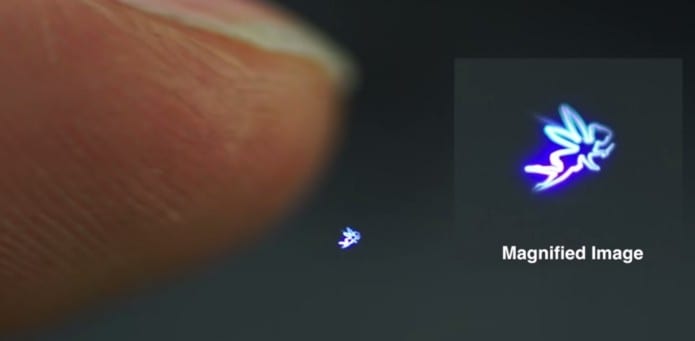Researchers turn to Femtosecond lasers to display touchable images in the air!
Japanese researchers used ultra quick lasers to create three dimensional holograms in air which can be touched and felt by humans.
Aerial Burton, a Japanese company, had been using lasers to ionize molecules of air in midair thus creating bright pixels that could float in space. Though the company had used this technology since past few years, they were in fact using the floating plasma which burnt the skin if anyone tried to touch it.
Researchers have now found a novel way of creating three dimensional, interactive holograms by using a combination of lasers, mirrors and cameras. These holograms are made up of tiny points of plasma light called as Voxels. Focused energy of a laser was used to ionize the surrounding air which resulted into creating the Voxels.
The highlight of this study was that these holograms could be felt and touched by humans safely without any burns. Volunteers participating in the tests have mentioned that these optical illusions when touched felt like sandpaper and sort of static shock, and it did not harm or burn their skin.
Researchers from the University of Tsukuba’s Digital Nature Group (DNG), Japan used special Femtosecond Lasers to display these touchable images in the air. The Femtosecond Lasers were transmitted in bursts of 30 to 270 Femtoseconds (1 Femtosecond is a quadrillionth of a second) indicating they were ultra quick lasers.
The Japanese DNG researchers used a combination of spatial light modulator, a mirror, a Galvano scanner and created shapes upto 1 cm cubed which had a resolution of around 200,000 dots-per-second at its highest setting. A Galvano scanner helped the researchers to precisely target the lasers.
With this high speed, researchers were able to get the holograms that responded to touch in real time. The addition of camera, which was placed underneath, used to monitor the finger and hand movements which further added a level of interactivity to these 3-D holograms.
Scientists were able achieve similar results in their previous experiments; however DNG research was slightly different because here researchers used very high resolution, for the very first time, which responded to touch in real time, without being damaged by the touch.
Researchers used shorter duration of the laser’s bursts to make these holograms much safer because otherwise these lasers can even burn skin. During the study researchers found that if the lasers were fired in more than two seconds then they had the capacity to burn the leather which simulated skin. However, when the lasers were transmitted at 50 milliseconds to 1 second bursts, the laser was safe and did not scathe the leather.
Yoichi Ochiai, leading the research team, said that the size of the spatial light modulator, which was a part of the setup, defined the size of the hologram. He further also added that he hopes to develop this proof-of-concept in his future ventures.
The DNG research team further explained: “The spatial light modulator [can] modify the phases of light rates and produce various spatial distributions of light based on interference. Our results led to calmer and safer plasma generation that can be incorporated into our daily lives.”
This novel technology could be used for guiding people during some emergency in the form of instructions (text and videos) as it can be directly displayed in the air without the help of screen. The technology can also be used in day to day activities such as to tick off a check list which is sort of hanging in air.
Scientists are currently working on increasing the size of these holograms and once this is achieved there could be a variety of fields where this technology can be used.
By using the same technology researchers displayed the projects in various mediums such as air, water, fluorescent solution and even across fluorescent plates.
SIGGRAPH 2015 exhibition would be held in the month of August from 11-13. This experiment has been submitted as a part of the exhibition which canvasses the new interactive techniques in computer graphics.
For details of the research study please visit here.
